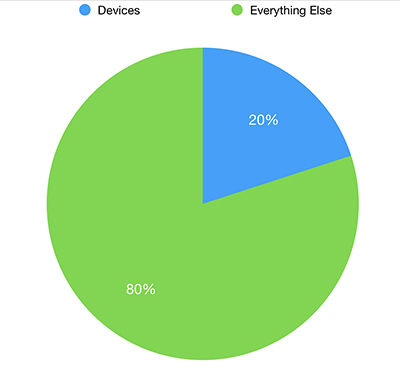



| By Dr. Ronald Hoffman

There are plenty of reasons to be anxious these days. There’s Covid, politics, the economy, looming environmental catastrophe, crime, the threat of World War III, not to mention the usual personal things—your health, your job or school, relationship dynamics, financial woes.
But lately, compounding all the usual affronts is something that I’ll call “device anxiety”. For me personally, I estimate device anxiety comprises around 20% of my total worry budget:

For example, I wake up to read my email, get the weather report and last night’s sports scores, check the day’s calendar, and glance at the newspaper headlines—and my iPad is unresponsive. My pulse races as the pages fail to load. What’s going on?! Is my superannuated device finally kicking the bucket? Does it simply need a reboot? Is it my router? Or the modem? Which one should I unplug? Is Verizon having an outage? Will I remember my password when I restart?
Or, when I get ready to record a podcast, the app that I rely on informs me there’s a new firmware update, and that the old one will no longer be supported. It’s just $49.99 for a new subscription, but will the new recorder be finicky? Will I lay down an entire interview with a hard-to-get guest and then—as has happened before to my dismay—the voice track is so distorted that it’s irretrievable?
Or when I expect an important message from someone, but I can’t figure out where it’s going to come from: Is it in one of my email accounts? Which one? Is it emanating from iMessages or Facebook Messenger? Or is coming from my LinkedIn, Twitter, or Doximity account? “Why don’t you answer?” I imagine them complaining. It’s because, to be instantaneously responsive, I’d literally have to monitor all my incoming from various sources 24/7!
Or how about watching TV? I’m old enough to remember when there were half a dozen channels (Spanish language and Home Shopping Network didn’t count). You’d simply pick up the remote and surf the (often meager) offerings.
Now, when you want to watch a ballgame, you have look up which of many channels it’ll appear on. Will it be, in the case of my home team the Yankees, on the YES network? Usually, unless YES broadcasts a woman’s basketball game or English Premier League Football. Then you have to search FOX Sports, ESPN, Amazon Prime, Apple TV, TNT or MLB. All of these require a subscription or a cable bundle. Even when you find the right channel, they require you to enter passwords and onscreen codes before they let you watch the game. Fumble a digit and you have to repeat the process. Meanwhile you’ve missed Aaron Judge’s latest home run!
Then there are movies and the latest binge-worthy series. But corporate America, in its eternal quest for profits, has decided to bifurcate offerings—Netflix, HBO, Paramount, Showtime, AMC, Hulu, Peacock, Amazon Prime, AppleTV Plus, etc.—so you’re locked out of your favorite show unless you maintain innumerable subscriptions. It gives me anxiety simply to contemplate how many I have, and whether I’m up to the gamesmanship required to optimize my entertainment budget. More expired passwords and unsuccessful logins, too.
There’s peripheral anxiety, too. With a camera, Go-Pro, headphones, and several mobile devices, tablets and computers and a need for power outlet converters on a foreign trip, I just throw a couple of pounds of electronic spaghetti into my suitcase and cross my fingers. Inevitably, there’s something I leave behind.
Other minor aggravations abound. Why does the music on my Apple Watch cut out mid-run, necessitating that I stop and fiddle with it? Why does my account on a medical app irretrievably confuse me with a famous oncologist whose name I happen to share, and congratulate me on my latest paper on myelodysplastic disorders (which I didn’t write)? Why does Apple Play in my car work sometimes, others not, seemingly at random? Why can’t I program the thermostat in my house? Every time my computer asks me for an update, and I finally relent, I cross my fingers and hope it won’t wipe out anything (believe me, it’s happened!).
There’s also the emerging role of electronic medical records—EMRs—a trend that I’ve bucked. More and more, insurance companies and Medicare are squeezing doctors into compliance with electronic submissions. That means investing in expensive, balky systems that steal face time from patients and turn physicians into slaves to their computers, constantly inputting data that often doesn’t comport with quality care. I’m a pen and paper holdout, the last of a dying breed.
Now some of this sounds like the grousing of an aging Baby Boomer. True, my life has straddled the analog/digital divide. It’s lucky that, as a teenager, during one boring summer when I couldn’t get a job, I signed up for a touch-typing course, thus anticipating the need to type on a computer, which I now do readily; I used a Dictaphone for the first decade of my career, and hired a transcriptionist until the advent of word processors in the 90s enabled me to type my own notes and articles. Now I’m happily banging away.
In high school, I wasn’t one of those prescient nerds who fed punch cards into a hulking IBM while coding ANS-COBOL. My wonky classmates are now mostly cashed out as Silicon Valley millionaires. But credit me and fellow Boomers as being adaptable; we braved the computer revolution and acquired new skills to keep up.
In an article entitled “5 Reasons Why Seniors Should Embrace Technology” a retirement community executive breezily claims: “Seniors who aren’t ‘plugged in’ may feel intimidated or overwhelmed by the idea of learning about new technology. However, the truth is that it’s easier than ever to learn about these new gadgets, and embracing them can enhance our lives in so many ways.”
This too easily dismisses the device anxiety that I know to be rampant among older Americans.
These days, kids learn skills as toddlers. They’re intuitive with devices, and their brains are wired to ace digital interactions. Even the preschoolers that I know are happily swiping their way to their favorite cartoons. But disturbing trends are emerging, even among the young. Medical Life Sciences News reports:
“In a study published in Addiction Biology, investigators found significant associations between use of electronic devices and signs of depression and anxiety, as well as cigarette smoking and alcohol drinking . . .Three indicators of use of electronic devices were included in the study: TV watching, computer using, and computer playing. According to the authors, the study’s findings suggest that reducing time spent using electronic devices may help reduce mental health burdens.”
And Medpage Today reports nearly one in four U.S. young adults were treated for mental health problems in 2021:
“The percentage of young U.S. adults [ages 18-44] receiving mental health treatment increased by nearly 5% from 2019 to 2021, according to National Health Interview Survey data. Overall, the proportion of adults receiving mental health treatment — defined as receiving counseling, therapy, taking a medication, or any combination of the three — increased from 19.2% in 2019 to 21.6% by 2021.”
Device anxiety—learn to live with it, I guess. Giving up is like acceding to the Grim Reaper. On the other hand, maybe it’s time to make our digital world more seamless, and less likely to compound our modern woes.
Though we think of declining estrogen as the hallmark of menopause, it's actually common for…

Up to 12 percent of Americans have ulcers at some point in life. Peptic ulcers…
Gallbladder disease is a modern illness. An estimated 20 million Americans have gallbladder disease. The…

There’s more to GI health than whether or not to take an acid-blocker. All too…

In the latest attempt to remove “stigma” from medical terminology, liver specialists have come up…

Q: My husband’s high sensitivity C-reactive protein (hs-CRP) is 1.62 and his homocysteine is 13.1. If…

Banish the Bloat: Leyla Weighs In with Tips and Insights

Our virtual voicemail is open 24/7, so there's no need to wait to submit your questions for Dr. Hoffman. Leave a message, and you may hear your question featured on the Intelligent Medicine radio program!